Environmental Health Policy: Aboriginal and Torres Strait
VerifiedAdded on 2023/01/23
|9
|2217
|90
Report
AI Summary
This report provides an overview of environmental health policies, specifically focusing on the Aboriginal and Torres Strait Islander environmental health plan. It aligns with national health plans, aiming to address chronic diseases and improve healthcare access. The report examines public concer...
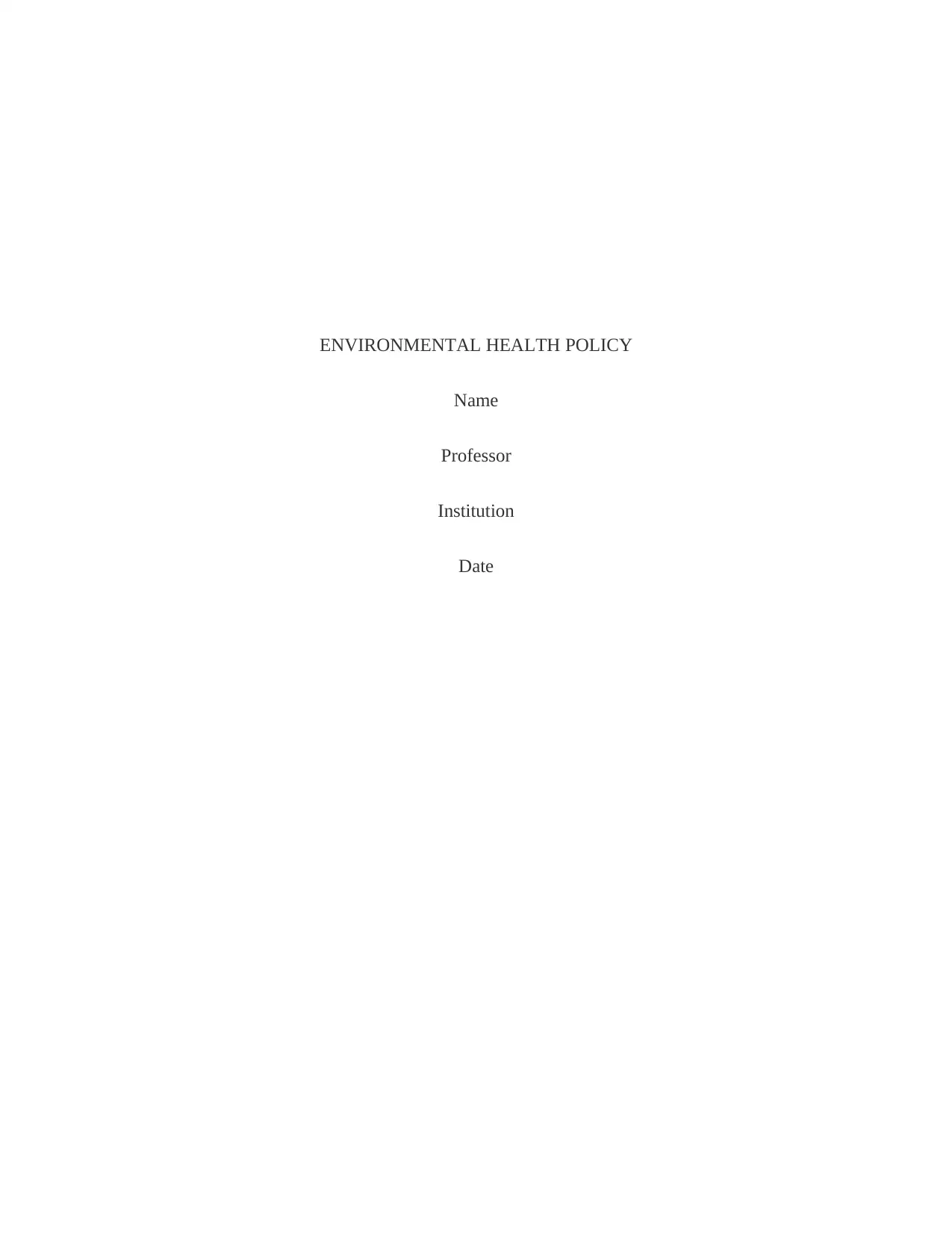
ENVIRONMENTAL HEALTH POLICY
Name
Professor
Institution
Date
Name
Professor
Institution
Date
Paraphrase This Document
Need a fresh take? Get an instant paraphrase of this document with our AI Paraphraser
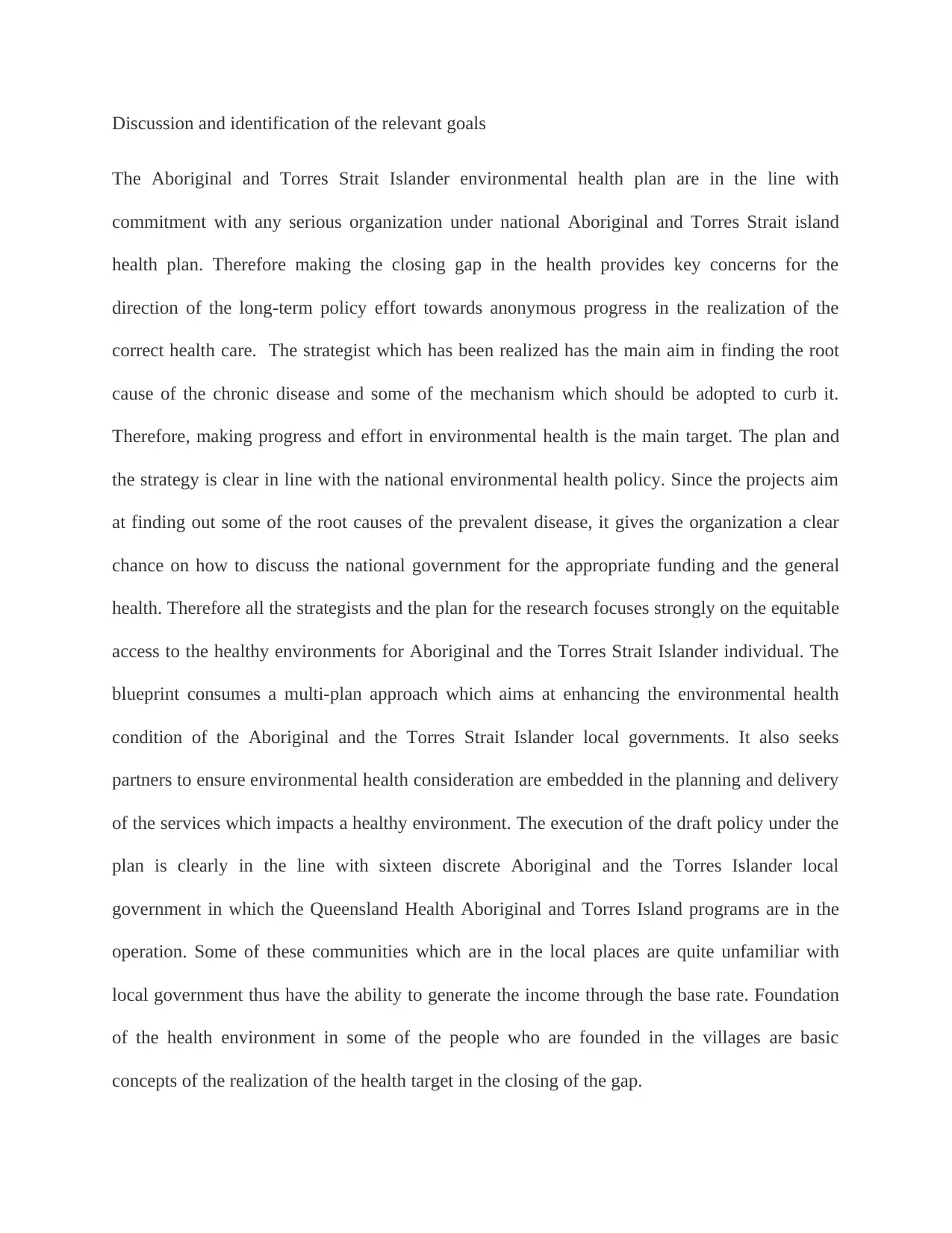
Discussion and identification of the relevant goals
The Aboriginal and Torres Strait Islander environmental health plan are in the line with
commitment with any serious organization under national Aboriginal and Torres Strait island
health plan. Therefore making the closing gap in the health provides key concerns for the
direction of the long-term policy effort towards anonymous progress in the realization of the
correct health care. The strategist which has been realized has the main aim in finding the root
cause of the chronic disease and some of the mechanism which should be adopted to curb it.
Therefore, making progress and effort in environmental health is the main target. The plan and
the strategy is clear in line with the national environmental health policy. Since the projects aim
at finding out some of the root causes of the prevalent disease, it gives the organization a clear
chance on how to discuss the national government for the appropriate funding and the general
health. Therefore all the strategists and the plan for the research focuses strongly on the equitable
access to the healthy environments for Aboriginal and the Torres Strait Islander individual. The
blueprint consumes a multi-plan approach which aims at enhancing the environmental health
condition of the Aboriginal and the Torres Strait Islander local governments. It also seeks
partners to ensure environmental health consideration are embedded in the planning and delivery
of the services which impacts a healthy environment. The execution of the draft policy under the
plan is clearly in the line with sixteen discrete Aboriginal and the Torres Islander local
government in which the Queensland Health Aboriginal and Torres Island programs are in the
operation. Some of these communities which are in the local places are quite unfamiliar with
local government thus have the ability to generate the income through the base rate. Foundation
of the health environment in some of the people who are founded in the villages are basic
concepts of the realization of the health target in the closing of the gap.
The Aboriginal and Torres Strait Islander environmental health plan are in the line with
commitment with any serious organization under national Aboriginal and Torres Strait island
health plan. Therefore making the closing gap in the health provides key concerns for the
direction of the long-term policy effort towards anonymous progress in the realization of the
correct health care. The strategist which has been realized has the main aim in finding the root
cause of the chronic disease and some of the mechanism which should be adopted to curb it.
Therefore, making progress and effort in environmental health is the main target. The plan and
the strategy is clear in line with the national environmental health policy. Since the projects aim
at finding out some of the root causes of the prevalent disease, it gives the organization a clear
chance on how to discuss the national government for the appropriate funding and the general
health. Therefore all the strategists and the plan for the research focuses strongly on the equitable
access to the healthy environments for Aboriginal and the Torres Strait Islander individual. The
blueprint consumes a multi-plan approach which aims at enhancing the environmental health
condition of the Aboriginal and the Torres Strait Islander local governments. It also seeks
partners to ensure environmental health consideration are embedded in the planning and delivery
of the services which impacts a healthy environment. The execution of the draft policy under the
plan is clearly in the line with sixteen discrete Aboriginal and the Torres Islander local
government in which the Queensland Health Aboriginal and Torres Island programs are in the
operation. Some of these communities which are in the local places are quite unfamiliar with
local government thus have the ability to generate the income through the base rate. Foundation
of the health environment in some of the people who are founded in the villages are basic
concepts of the realization of the health target in the closing of the gap.
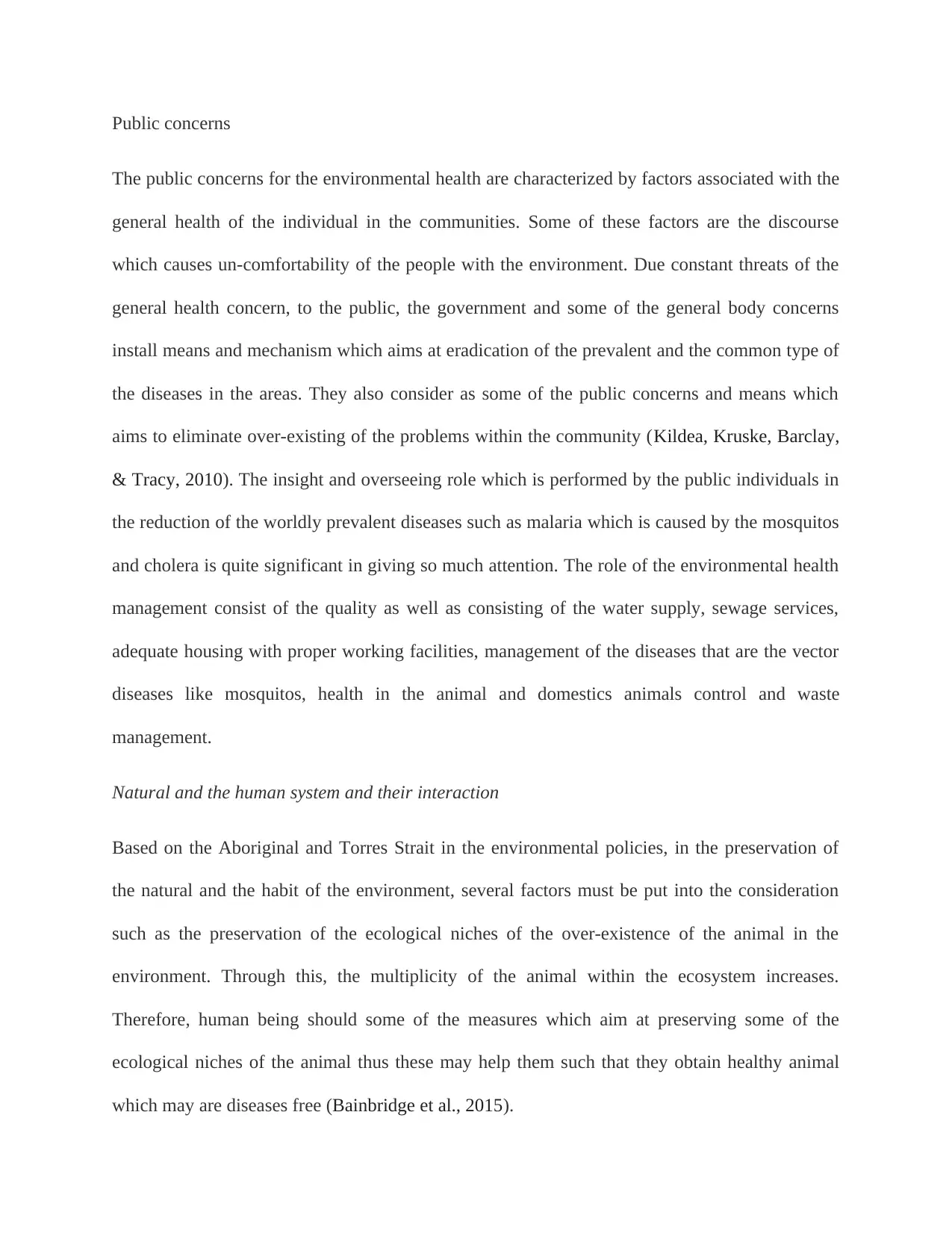
Public concerns
The public concerns for the environmental health are characterized by factors associated with the
general health of the individual in the communities. Some of these factors are the discourse
which causes un-comfortability of the people with the environment. Due constant threats of the
general health concern, to the public, the government and some of the general body concerns
install means and mechanism which aims at eradication of the prevalent and the common type of
the diseases in the areas. They also consider as some of the public concerns and means which
aims to eliminate over-existing of the problems within the community (Kildea, Kruske, Barclay,
& Tracy, 2010). The insight and overseeing role which is performed by the public individuals in
the reduction of the worldly prevalent diseases such as malaria which is caused by the mosquitos
and cholera is quite significant in giving so much attention. The role of the environmental health
management consist of the quality as well as consisting of the water supply, sewage services,
adequate housing with proper working facilities, management of the diseases that are the vector
diseases like mosquitos, health in the animal and domestics animals control and waste
management.
Natural and the human system and their interaction
Based on the Aboriginal and Torres Strait in the environmental policies, in the preservation of
the natural and the habit of the environment, several factors must be put into the consideration
such as the preservation of the ecological niches of the over-existence of the animal in the
environment. Through this, the multiplicity of the animal within the ecosystem increases.
Therefore, human being should some of the measures which aim at preserving some of the
ecological niches of the animal thus these may help them such that they obtain healthy animal
which may are diseases free (Bainbridge et al., 2015).
The public concerns for the environmental health are characterized by factors associated with the
general health of the individual in the communities. Some of these factors are the discourse
which causes un-comfortability of the people with the environment. Due constant threats of the
general health concern, to the public, the government and some of the general body concerns
install means and mechanism which aims at eradication of the prevalent and the common type of
the diseases in the areas. They also consider as some of the public concerns and means which
aims to eliminate over-existing of the problems within the community (Kildea, Kruske, Barclay,
& Tracy, 2010). The insight and overseeing role which is performed by the public individuals in
the reduction of the worldly prevalent diseases such as malaria which is caused by the mosquitos
and cholera is quite significant in giving so much attention. The role of the environmental health
management consist of the quality as well as consisting of the water supply, sewage services,
adequate housing with proper working facilities, management of the diseases that are the vector
diseases like mosquitos, health in the animal and domestics animals control and waste
management.
Natural and the human system and their interaction
Based on the Aboriginal and Torres Strait in the environmental policies, in the preservation of
the natural and the habit of the environment, several factors must be put into the consideration
such as the preservation of the ecological niches of the over-existence of the animal in the
environment. Through this, the multiplicity of the animal within the ecosystem increases.
Therefore, human being should some of the measures which aim at preserving some of the
ecological niches of the animal thus these may help them such that they obtain healthy animal
which may are diseases free (Bainbridge et al., 2015).
⊘ This is a preview!⊘
Do you want full access?
Subscribe today to unlock all pages.

Trusted by 1+ million students worldwide
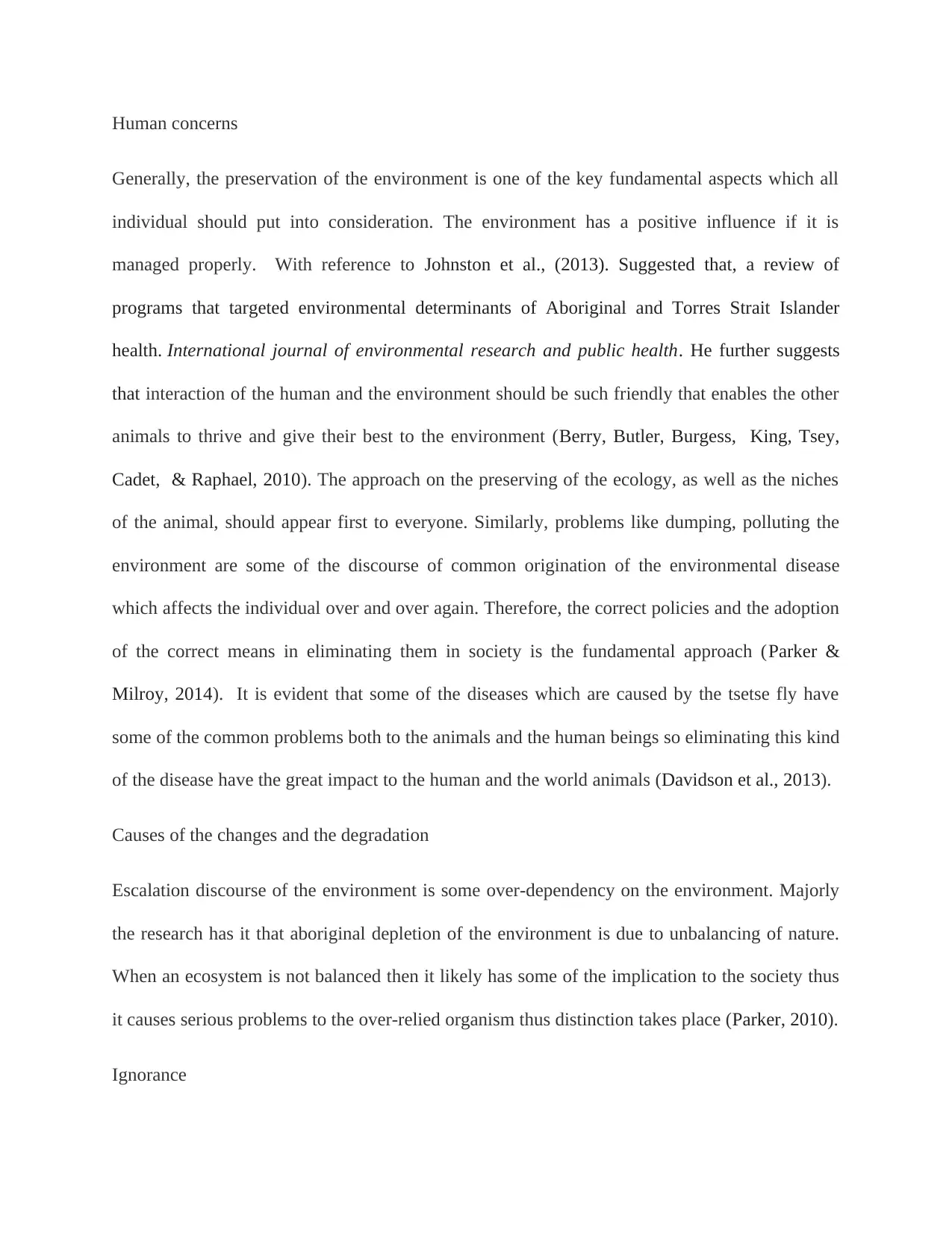
Human concerns
Generally, the preservation of the environment is one of the key fundamental aspects which all
individual should put into consideration. The environment has a positive influence if it is
managed properly. With reference to Johnston et al., (2013). Suggested that, a review of
programs that targeted environmental determinants of Aboriginal and Torres Strait Islander
health. International journal of environmental research and public health. He further suggests
that interaction of the human and the environment should be such friendly that enables the other
animals to thrive and give their best to the environment (Berry, Butler, Burgess, King, Tsey,
Cadet, & Raphael, 2010). The approach on the preserving of the ecology, as well as the niches
of the animal, should appear first to everyone. Similarly, problems like dumping, polluting the
environment are some of the discourse of common origination of the environmental disease
which affects the individual over and over again. Therefore, the correct policies and the adoption
of the correct means in eliminating them in society is the fundamental approach (Parker &
Milroy, 2014). It is evident that some of the diseases which are caused by the tsetse fly have
some of the common problems both to the animals and the human beings so eliminating this kind
of the disease have the great impact to the human and the world animals (Davidson et al., 2013).
Causes of the changes and the degradation
Escalation discourse of the environment is some over-dependency on the environment. Majorly
the research has it that aboriginal depletion of the environment is due to unbalancing of nature.
When an ecosystem is not balanced then it likely has some of the implication to the society thus
it causes serious problems to the over-relied organism thus distinction takes place (Parker, 2010).
Ignorance
Generally, the preservation of the environment is one of the key fundamental aspects which all
individual should put into consideration. The environment has a positive influence if it is
managed properly. With reference to Johnston et al., (2013). Suggested that, a review of
programs that targeted environmental determinants of Aboriginal and Torres Strait Islander
health. International journal of environmental research and public health. He further suggests
that interaction of the human and the environment should be such friendly that enables the other
animals to thrive and give their best to the environment (Berry, Butler, Burgess, King, Tsey,
Cadet, & Raphael, 2010). The approach on the preserving of the ecology, as well as the niches
of the animal, should appear first to everyone. Similarly, problems like dumping, polluting the
environment are some of the discourse of common origination of the environmental disease
which affects the individual over and over again. Therefore, the correct policies and the adoption
of the correct means in eliminating them in society is the fundamental approach (Parker &
Milroy, 2014). It is evident that some of the diseases which are caused by the tsetse fly have
some of the common problems both to the animals and the human beings so eliminating this kind
of the disease have the great impact to the human and the world animals (Davidson et al., 2013).
Causes of the changes and the degradation
Escalation discourse of the environment is some over-dependency on the environment. Majorly
the research has it that aboriginal depletion of the environment is due to unbalancing of nature.
When an ecosystem is not balanced then it likely has some of the implication to the society thus
it causes serious problems to the over-relied organism thus distinction takes place (Parker, 2010).
Ignorance
Paraphrase This Document
Need a fresh take? Get an instant paraphrase of this document with our AI Paraphraser
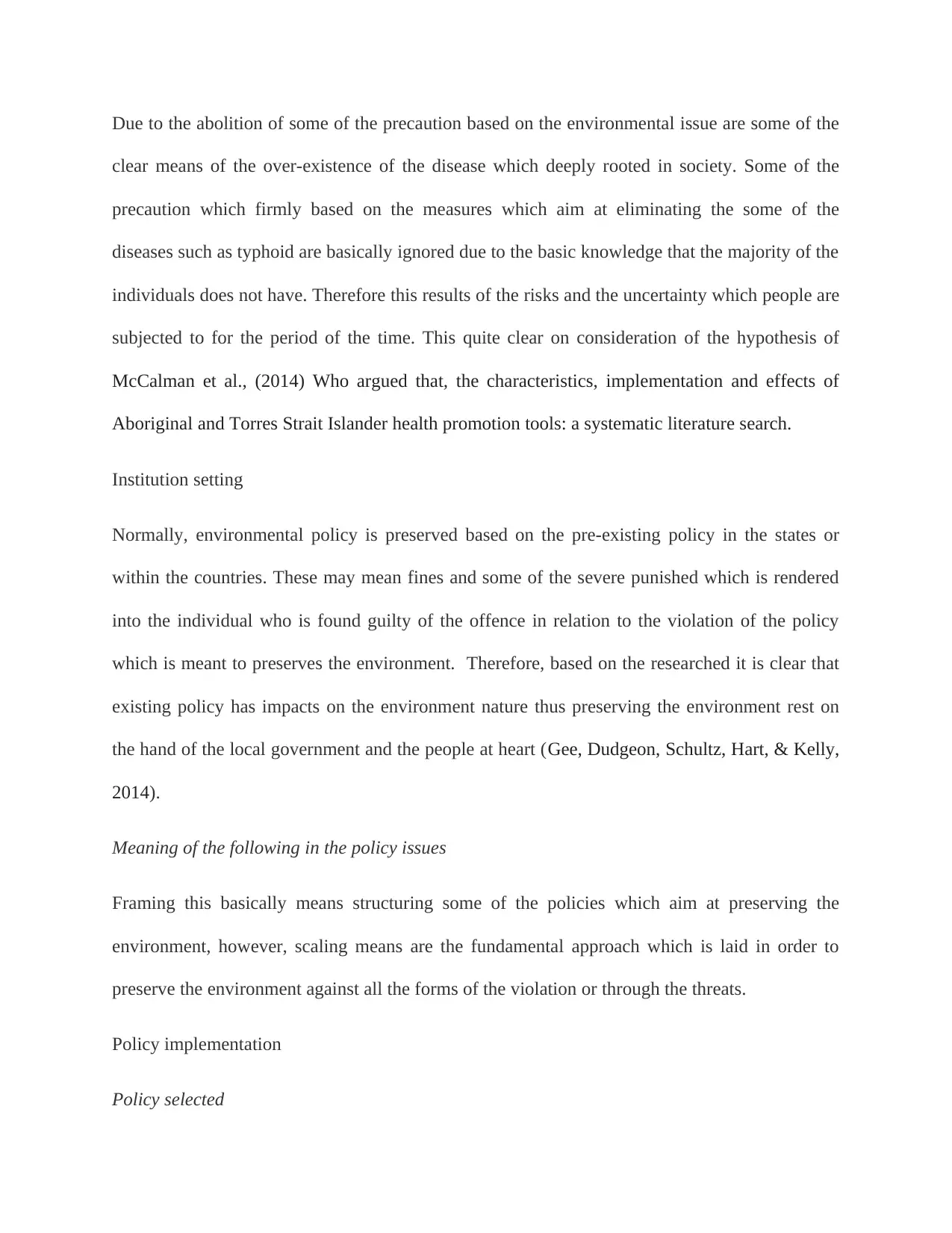
Due to the abolition of some of the precaution based on the environmental issue are some of the
clear means of the over-existence of the disease which deeply rooted in society. Some of the
precaution which firmly based on the measures which aim at eliminating the some of the
diseases such as typhoid are basically ignored due to the basic knowledge that the majority of the
individuals does not have. Therefore this results of the risks and the uncertainty which people are
subjected to for the period of the time. This quite clear on consideration of the hypothesis of
McCalman et al., (2014) Who argued that, the characteristics, implementation and effects of
Aboriginal and Torres Strait Islander health promotion tools: a systematic literature search.
Institution setting
Normally, environmental policy is preserved based on the pre-existing policy in the states or
within the countries. These may mean fines and some of the severe punished which is rendered
into the individual who is found guilty of the offence in relation to the violation of the policy
which is meant to preserves the environment. Therefore, based on the researched it is clear that
existing policy has impacts on the environment nature thus preserving the environment rest on
the hand of the local government and the people at heart (Gee, Dudgeon, Schultz, Hart, & Kelly,
2014).
Meaning of the following in the policy issues
Framing this basically means structuring some of the policies which aim at preserving the
environment, however, scaling means are the fundamental approach which is laid in order to
preserve the environment against all the forms of the violation or through the threats.
Policy implementation
Policy selected
clear means of the over-existence of the disease which deeply rooted in society. Some of the
precaution which firmly based on the measures which aim at eliminating the some of the
diseases such as typhoid are basically ignored due to the basic knowledge that the majority of the
individuals does not have. Therefore this results of the risks and the uncertainty which people are
subjected to for the period of the time. This quite clear on consideration of the hypothesis of
McCalman et al., (2014) Who argued that, the characteristics, implementation and effects of
Aboriginal and Torres Strait Islander health promotion tools: a systematic literature search.
Institution setting
Normally, environmental policy is preserved based on the pre-existing policy in the states or
within the countries. These may mean fines and some of the severe punished which is rendered
into the individual who is found guilty of the offence in relation to the violation of the policy
which is meant to preserves the environment. Therefore, based on the researched it is clear that
existing policy has impacts on the environment nature thus preserving the environment rest on
the hand of the local government and the people at heart (Gee, Dudgeon, Schultz, Hart, & Kelly,
2014).
Meaning of the following in the policy issues
Framing this basically means structuring some of the policies which aim at preserving the
environment, however, scaling means are the fundamental approach which is laid in order to
preserve the environment against all the forms of the violation or through the threats.
Policy implementation
Policy selected
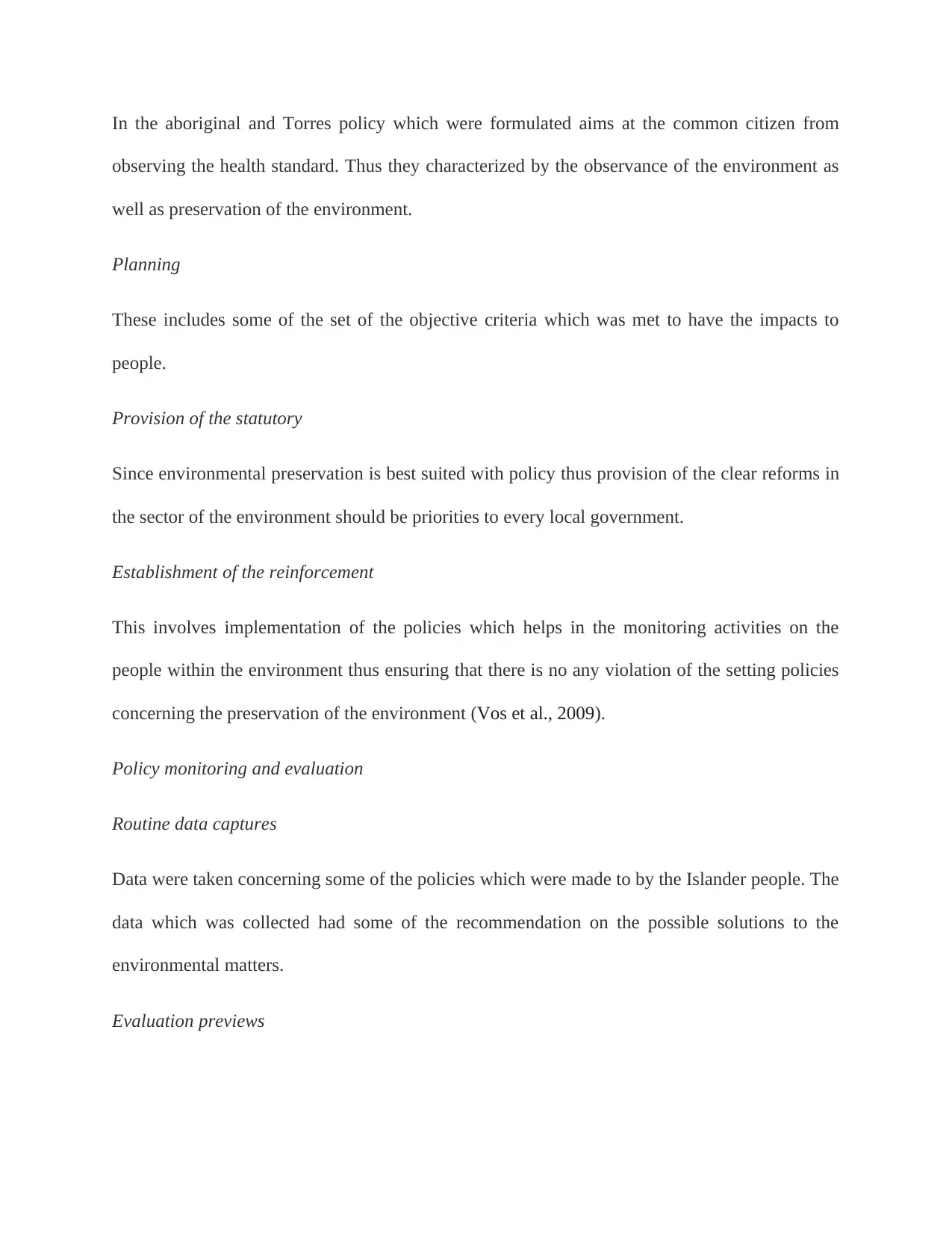
In the aboriginal and Torres policy which were formulated aims at the common citizen from
observing the health standard. Thus they characterized by the observance of the environment as
well as preservation of the environment.
Planning
These includes some of the set of the objective criteria which was met to have the impacts to
people.
Provision of the statutory
Since environmental preservation is best suited with policy thus provision of the clear reforms in
the sector of the environment should be priorities to every local government.
Establishment of the reinforcement
This involves implementation of the policies which helps in the monitoring activities on the
people within the environment thus ensuring that there is no any violation of the setting policies
concerning the preservation of the environment (Vos et al., 2009).
Policy monitoring and evaluation
Routine data captures
Data were taken concerning some of the policies which were made to by the Islander people. The
data which was collected had some of the recommendation on the possible solutions to the
environmental matters.
Evaluation previews
observing the health standard. Thus they characterized by the observance of the environment as
well as preservation of the environment.
Planning
These includes some of the set of the objective criteria which was met to have the impacts to
people.
Provision of the statutory
Since environmental preservation is best suited with policy thus provision of the clear reforms in
the sector of the environment should be priorities to every local government.
Establishment of the reinforcement
This involves implementation of the policies which helps in the monitoring activities on the
people within the environment thus ensuring that there is no any violation of the setting policies
concerning the preservation of the environment (Vos et al., 2009).
Policy monitoring and evaluation
Routine data captures
Data were taken concerning some of the policies which were made to by the Islander people. The
data which was collected had some of the recommendation on the possible solutions to the
environmental matters.
Evaluation previews
⊘ This is a preview!⊘
Do you want full access?
Subscribe today to unlock all pages.

Trusted by 1+ million students worldwide
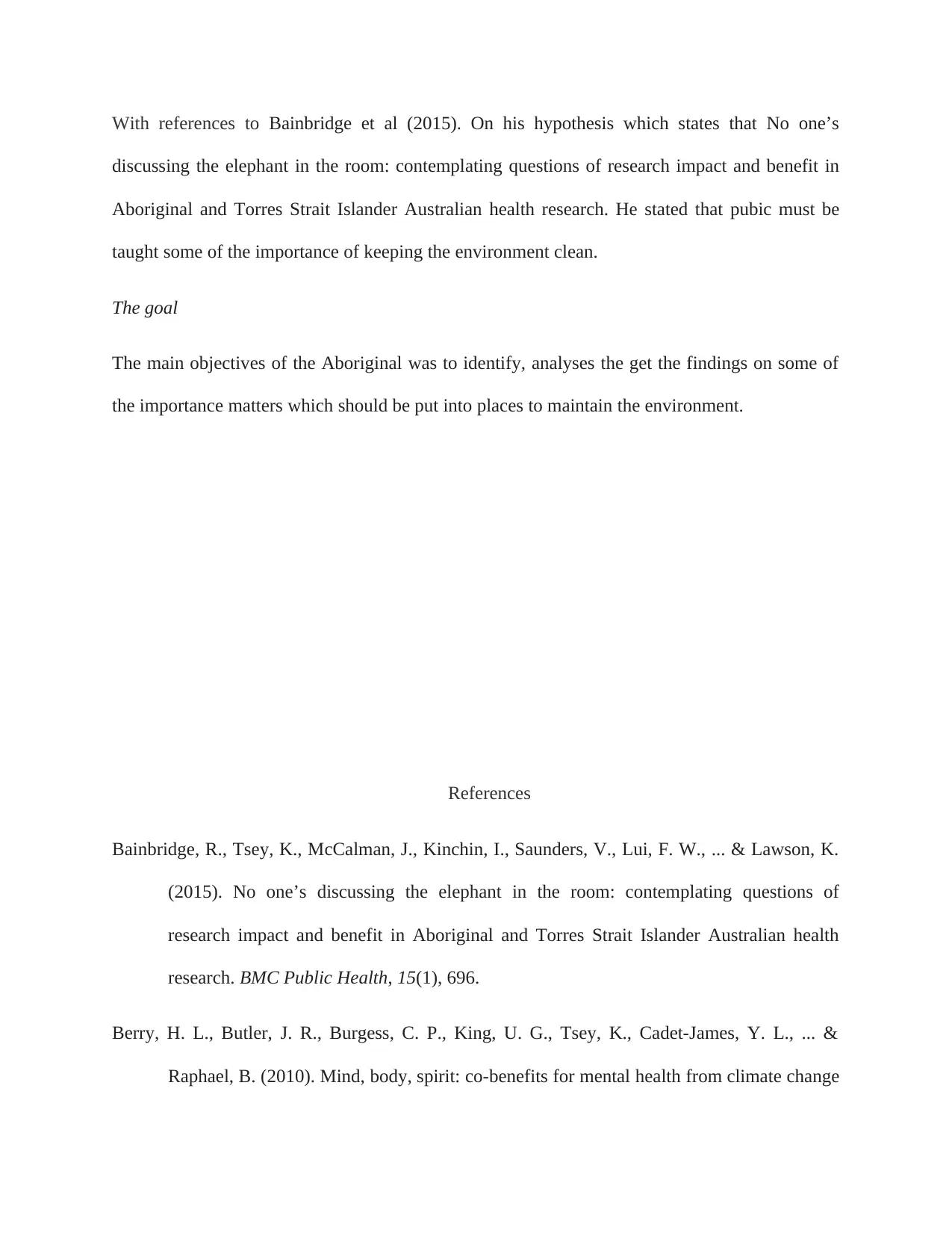
With references to Bainbridge et al (2015). On his hypothesis which states that No one’s
discussing the elephant in the room: contemplating questions of research impact and benefit in
Aboriginal and Torres Strait Islander Australian health research. He stated that pubic must be
taught some of the importance of keeping the environment clean.
The goal
The main objectives of the Aboriginal was to identify, analyses the get the findings on some of
the importance matters which should be put into places to maintain the environment.
References
Bainbridge, R., Tsey, K., McCalman, J., Kinchin, I., Saunders, V., Lui, F. W., ... & Lawson, K.
(2015). No one’s discussing the elephant in the room: contemplating questions of
research impact and benefit in Aboriginal and Torres Strait Islander Australian health
research. BMC Public Health, 15(1), 696.
Berry, H. L., Butler, J. R., Burgess, C. P., King, U. G., Tsey, K., Cadet-James, Y. L., ... &
Raphael, B. (2010). Mind, body, spirit: co-benefits for mental health from climate change
discussing the elephant in the room: contemplating questions of research impact and benefit in
Aboriginal and Torres Strait Islander Australian health research. He stated that pubic must be
taught some of the importance of keeping the environment clean.
The goal
The main objectives of the Aboriginal was to identify, analyses the get the findings on some of
the importance matters which should be put into places to maintain the environment.
References
Bainbridge, R., Tsey, K., McCalman, J., Kinchin, I., Saunders, V., Lui, F. W., ... & Lawson, K.
(2015). No one’s discussing the elephant in the room: contemplating questions of
research impact and benefit in Aboriginal and Torres Strait Islander Australian health
research. BMC Public Health, 15(1), 696.
Berry, H. L., Butler, J. R., Burgess, C. P., King, U. G., Tsey, K., Cadet-James, Y. L., ... &
Raphael, B. (2010). Mind, body, spirit: co-benefits for mental health from climate change
Paraphrase This Document
Need a fresh take? Get an instant paraphrase of this document with our AI Paraphraser
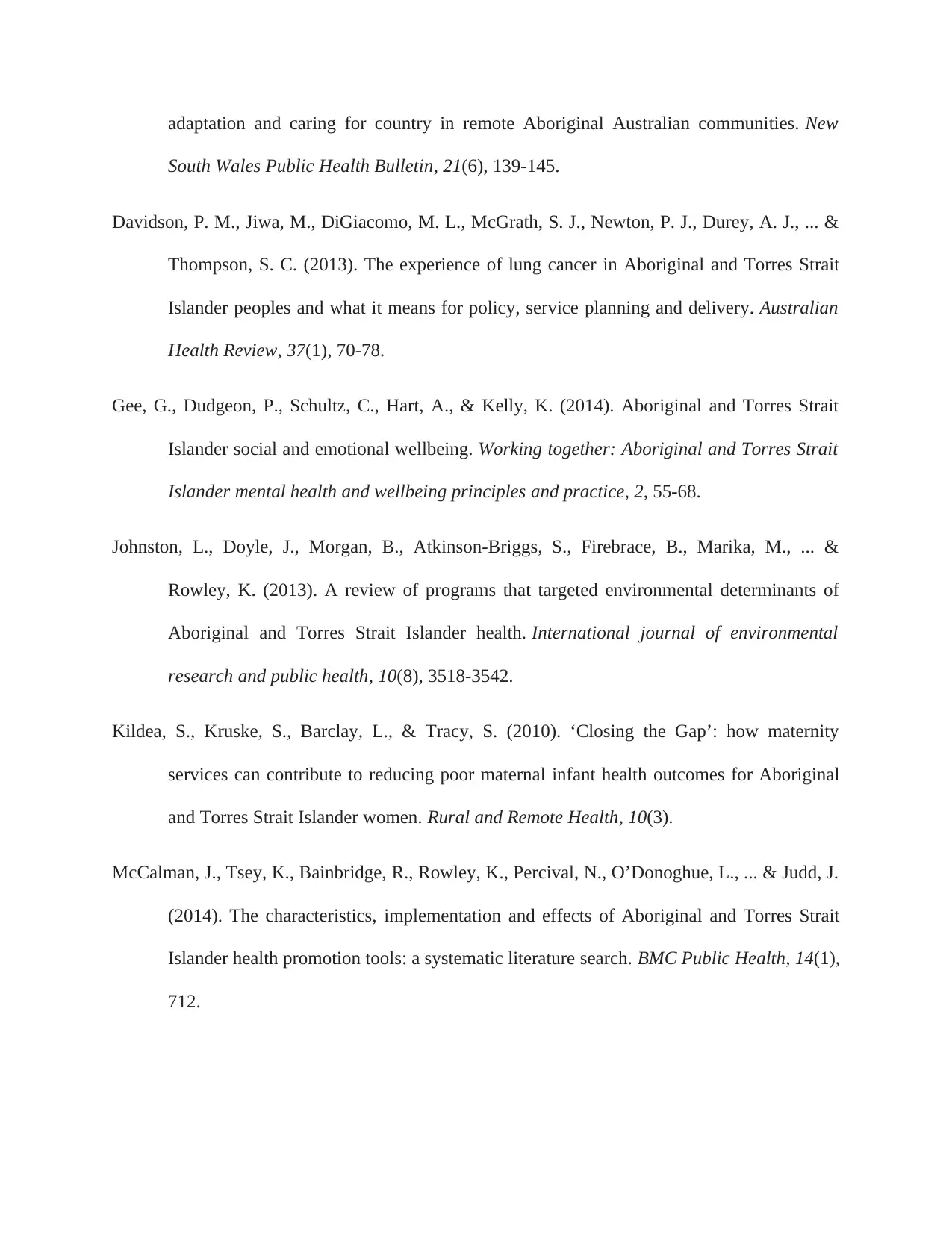
adaptation and caring for country in remote Aboriginal Australian communities. New
South Wales Public Health Bulletin, 21(6), 139-145.
Davidson, P. M., Jiwa, M., DiGiacomo, M. L., McGrath, S. J., Newton, P. J., Durey, A. J., ... &
Thompson, S. C. (2013). The experience of lung cancer in Aboriginal and Torres Strait
Islander peoples and what it means for policy, service planning and delivery. Australian
Health Review, 37(1), 70-78.
Gee, G., Dudgeon, P., Schultz, C., Hart, A., & Kelly, K. (2014). Aboriginal and Torres Strait
Islander social and emotional wellbeing. Working together: Aboriginal and Torres Strait
Islander mental health and wellbeing principles and practice, 2, 55-68.
Johnston, L., Doyle, J., Morgan, B., Atkinson-Briggs, S., Firebrace, B., Marika, M., ... &
Rowley, K. (2013). A review of programs that targeted environmental determinants of
Aboriginal and Torres Strait Islander health. International journal of environmental
research and public health, 10(8), 3518-3542.
Kildea, S., Kruske, S., Barclay, L., & Tracy, S. (2010). ‘Closing the Gap’: how maternity
services can contribute to reducing poor maternal infant health outcomes for Aboriginal
and Torres Strait Islander women. Rural and Remote Health, 10(3).
McCalman, J., Tsey, K., Bainbridge, R., Rowley, K., Percival, N., O’Donoghue, L., ... & Judd, J.
(2014). The characteristics, implementation and effects of Aboriginal and Torres Strait
Islander health promotion tools: a systematic literature search. BMC Public Health, 14(1),
712.
South Wales Public Health Bulletin, 21(6), 139-145.
Davidson, P. M., Jiwa, M., DiGiacomo, M. L., McGrath, S. J., Newton, P. J., Durey, A. J., ... &
Thompson, S. C. (2013). The experience of lung cancer in Aboriginal and Torres Strait
Islander peoples and what it means for policy, service planning and delivery. Australian
Health Review, 37(1), 70-78.
Gee, G., Dudgeon, P., Schultz, C., Hart, A., & Kelly, K. (2014). Aboriginal and Torres Strait
Islander social and emotional wellbeing. Working together: Aboriginal and Torres Strait
Islander mental health and wellbeing principles and practice, 2, 55-68.
Johnston, L., Doyle, J., Morgan, B., Atkinson-Briggs, S., Firebrace, B., Marika, M., ... &
Rowley, K. (2013). A review of programs that targeted environmental determinants of
Aboriginal and Torres Strait Islander health. International journal of environmental
research and public health, 10(8), 3518-3542.
Kildea, S., Kruske, S., Barclay, L., & Tracy, S. (2010). ‘Closing the Gap’: how maternity
services can contribute to reducing poor maternal infant health outcomes for Aboriginal
and Torres Strait Islander women. Rural and Remote Health, 10(3).
McCalman, J., Tsey, K., Bainbridge, R., Rowley, K., Percival, N., O’Donoghue, L., ... & Judd, J.
(2014). The characteristics, implementation and effects of Aboriginal and Torres Strait
Islander health promotion tools: a systematic literature search. BMC Public Health, 14(1),
712.
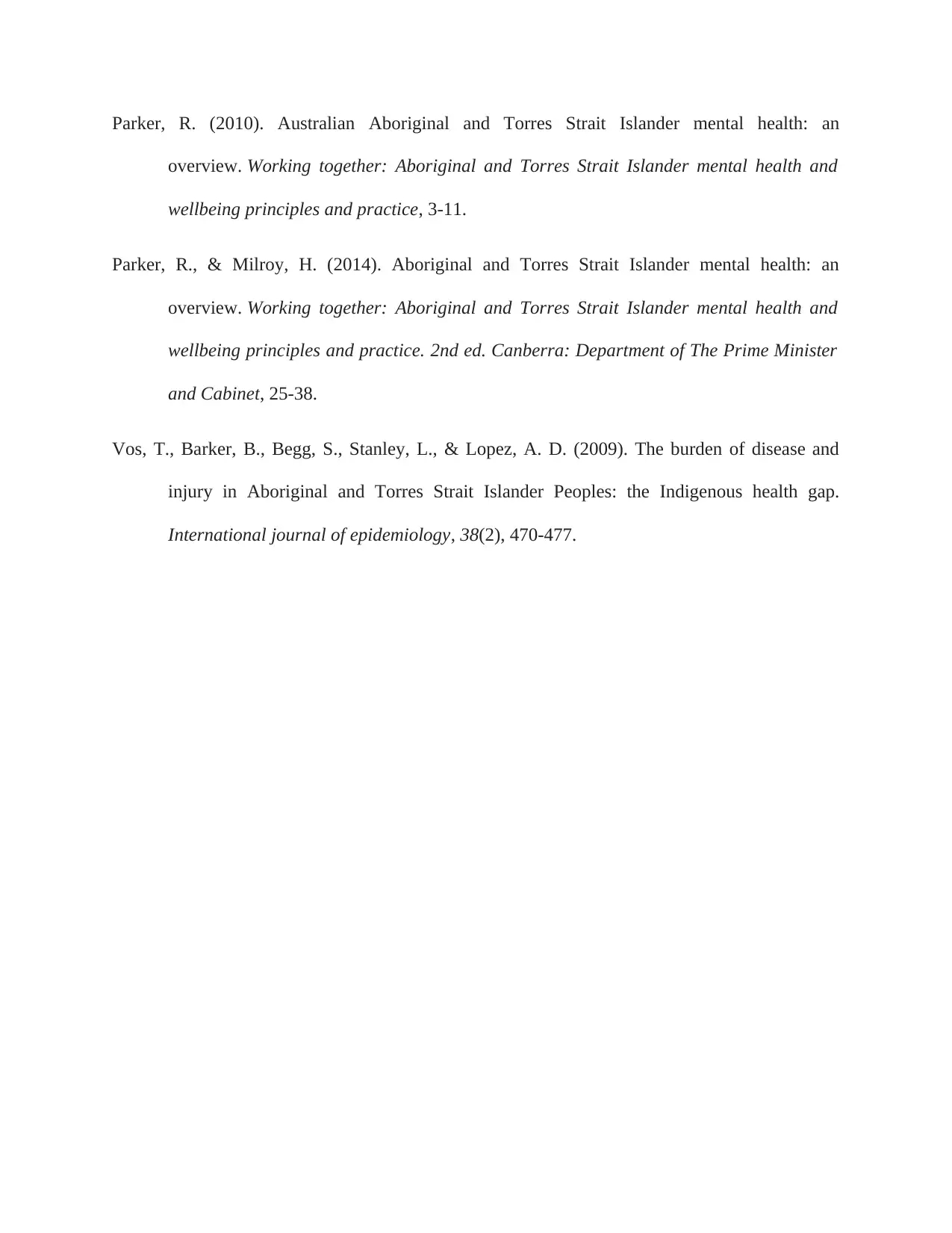
Parker, R. (2010). Australian Aboriginal and Torres Strait Islander mental health: an
overview. Working together: Aboriginal and Torres Strait Islander mental health and
wellbeing principles and practice, 3-11.
Parker, R., & Milroy, H. (2014). Aboriginal and Torres Strait Islander mental health: an
overview. Working together: Aboriginal and Torres Strait Islander mental health and
wellbeing principles and practice. 2nd ed. Canberra: Department of The Prime Minister
and Cabinet, 25-38.
Vos, T., Barker, B., Begg, S., Stanley, L., & Lopez, A. D. (2009). The burden of disease and
injury in Aboriginal and Torres Strait Islander Peoples: the Indigenous health gap.
International journal of epidemiology, 38(2), 470-477.
overview. Working together: Aboriginal and Torres Strait Islander mental health and
wellbeing principles and practice, 3-11.
Parker, R., & Milroy, H. (2014). Aboriginal and Torres Strait Islander mental health: an
overview. Working together: Aboriginal and Torres Strait Islander mental health and
wellbeing principles and practice. 2nd ed. Canberra: Department of The Prime Minister
and Cabinet, 25-38.
Vos, T., Barker, B., Begg, S., Stanley, L., & Lopez, A. D. (2009). The burden of disease and
injury in Aboriginal and Torres Strait Islander Peoples: the Indigenous health gap.
International journal of epidemiology, 38(2), 470-477.
⊘ This is a preview!⊘
Do you want full access?
Subscribe today to unlock all pages.

Trusted by 1+ million students worldwide
1 out of 9
Related Documents
Your All-in-One AI-Powered Toolkit for Academic Success.
+13062052269
info@desklib.com
Available 24*7 on WhatsApp / Email
![[object Object]](/_next/static/media/star-bottom.7253800d.svg)
Unlock your academic potential
© 2024 | Zucol Services PVT LTD | All rights reserved.





